Call the installer for the password, or you can reset the inverter and set a new password yourself

Czy wolisz polską wersję strony elektroda?
Nie, dziękuję Przekieruj mnie tam
sensor:
- platform: huawei_solar
host: '192.168.3.43'
optimizers: true
battery: false
slave: 1
sensor:
- platform: template
sensors:
pv_01_voltage:
friendly_name: "String 1 napięcie"
unit_of_measurement: 'V'
icon_template: mdi:flash-alert-outline
value_template: "{{ state_attr('sensor.sun2000_8ktl_m1', 'pv_string_01_voltage') }}"
pv_02_voltage:
friendly_name: "String 2 napięcie"
unit_of_measurement: 'V'
icon_template: mdi:flash-alert-outline
value_template: "{{ state_attr('sensor.sun2000_8ktl_m1', 'pv_string_02_voltage') }}"
pv_01_current:
friendly_name: "String 1 natężenie"
unit_of_measurement: 'A'
icon_template: mdi:current-dc
value_template: "{{ state_attr('sensor.sun2000_8ktl_m1', 'pv_string_01_current') }}"
pv_02_current:
friendly_name: "String 2 natężenie"
unit_of_measurement: 'A'
icon_template: mdi:current-dc
value_template: "{{ state_attr('sensor.sun2000_8ktl_m1', 'pv_string_02_current') }}"
phase_a_voltage:
friendly_name: "Faza 1 V (f)"
unit_of_measurement: 'V'
icon_template: mdi:flash-alert-outline
value_template: "{{ state_attr('sensor.sun2000_8ktl_m1', 'phase_A_voltage') }}"
phase_b_voltage:
friendly_name: "Faza 2 V (f)"
unit_of_measurement: 'V'
icon_template: mdi:flash-alert-outline
value_template: "{{ state_attr('sensor.sun2000_8ktl_m1', 'phase_B_voltage') }}"
phase_c_voltage:
friendly_name: "Faza 3 V (f)"
unit_of_measurement: 'V'
icon_template: mdi:flash-alert-outline
value_template: "{{ state_attr('sensor.sun2000_8ktl_m1', 'phase_C_voltage') }}"
m_grid_a_voltage:
friendly_name: "Faza 1 V (m)"
unit_of_measurement: 'V'
icon_template: mdi:flash-alert-outline
value_template: "{{ state_attr('sensor.sun2000_8ktl_m1', 'grid_A_voltage') }}"
m_grid_b_voltage:
friendly_name: "Faza 2 V (m)"
unit_of_measurement: 'V'
icon_template: mdi:flash-alert-outline
value_template: "{{ state_attr('sensor.sun2000_8ktl_m1', 'grid_B_voltage') }}"
m_grid_c_voltage:
friendly_name: "Faza 3 V (m)"
unit_of_measurement: 'V'
icon_template: mdi:flash-alert-outline
value_template: "{{ state_attr('sensor.sun2000_8ktl_m1', 'grid_C_voltage') }}"
phase_a_current:
friendly_name: "Faza 1 A (f)"
unit_of_measurement: 'A'
icon_template: mdi:current-ac
value_template: "{{ state_attr('sensor.sun2000_8ktl_m1', 'phase_A_current') }}"
phase_b_current:
friendly_name: "Faza 2 A (f)"
unit_of_measurement: 'A'
icon_template: mdi:current-ac
value_template: "{{ state_attr('sensor.sun2000_8ktl_m1', 'phase_B_current') }}"
phase_c_current:
friendly_name: "Faza 3 A (f)"
unit_of_measurement: 'A'
icon_template: mdi:current-ac
value_template: "{{ state_attr('sensor.sun2000_8ktl_m1', 'phase_C_current') }}"
pv_input_power:
friendly_name: "Produkcja DC"
unit_of_measurement: 'W'
icon_template: mdi:solar-power
value_template: "{{ state_attr('sensor.sun2000_8ktl_m1', 'input_power') }}"
power_meter_active_power:
friendly_name: "Zużycie prądu"
unit_of_measurement: 'W'
icon_template: mdi:transmission-tower
value_template: "{{ state_attr('sensor.sun2000_8ktl_m1', 'power_meter_active_power') }}"
active_grid_a_power:
friendly_name: "Zużycie A"
unit_of_measurement: 'W'
icon_template: mdi:transmission-tower
value_template: "{{ state_attr('sensor.sun2000_8ktl_m1', 'active_grid_A_power') }}"
active_grid_b_power:
friendly_name: "Zużycie B"
unit_of_measurement: 'W'
icon_template: mdi:transmission-tower
value_template: "{{ state_attr('sensor.sun2000_8ktl_m1', 'active_grid_B_power') }}"
active_grid_c_power:
friendly_name: "Zużycie C"
unit_of_measurement: 'W'
icon_template: mdi:transmission-tower
value_template: "{{ state_attr('sensor.sun2000_8ktl_m1', 'active_grid_C_power') }}"
m_grid_exporterd_energy:
friendly_name: "Prąd oddany do sieci"
unit_of_measurement: 'kWh'
icon_template: mdi:transmission-tower
value_template: "{{ state_attr('sensor.sun2000_8ktl_m1', 'grid_exporterd_energy') }}"
m_grid_accumulated_energy:
friendly_name: "Prąd pobrany z sieci"
unit_of_measurement: 'kWh'
icon_template: mdi:transmission-tower
value_template: "{{ state_attr('sensor.sun2000_8ktl_m1', 'grid_accumulated_energy') }}"
daily_yield:
friendly_name: "Produkcja dziś"
unit_of_measurement: 'kWh'
icon_template: mdi:transmission-tower
value_template: "{{ state_attr('sensor.sun2000_8ktl_m1', 'daily_yield') }}"
total_yield:
friendly_name: "Produkcja total"
unit_of_measurement: 'kWh'
icon_template: mdi:transmission-tower
value_template: "{{ state_attr('sensor.sun2000_8ktl_m1', 'total_yield') }}"
pv_temperatura:
friendly_name: "Temperatura falownika"
unit_of_measurement: '°C'
value_template: "{{ state_attr('sensor.sun2000_8ktl_m1', 'internal_temperature') }}"
pv_efficiency:
friendly_name: "Efetywność Falownika"
unit_of_measurement: '%'
value_template: >
{% if state_attr('sensor.sun2000_8ktl_m1', 'efficiency')|float < 100 %}
{{ state_attr('sensor.sun2000_8ktl_m1', 'efficiency') }}
{% else %}
0
{% endif %}
energy_used:
friendly_name: "Zużycie prądu dom"
unit_of_measurement: 'kWh'
value_template: >
{{ '%0.2f' | format(states('sensor.total_yield') | float -
states('sensor.m_grid_exporterd_energy') | float +
states('sensor.m_grid_accumulated_energy') | float) }}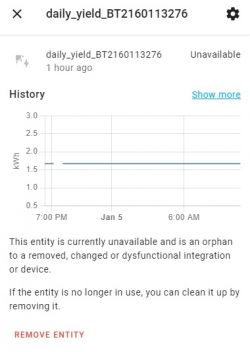

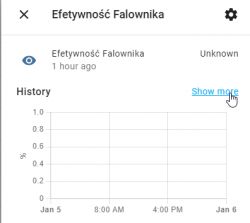

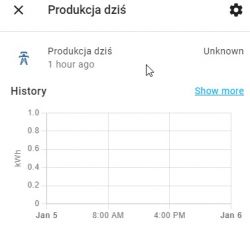
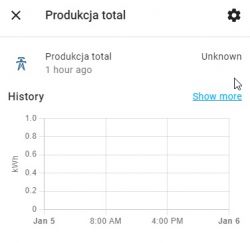
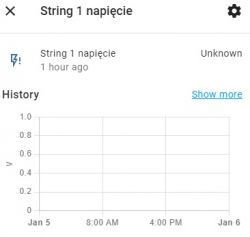
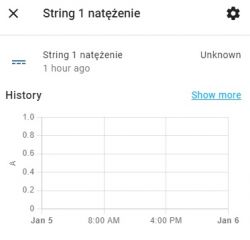
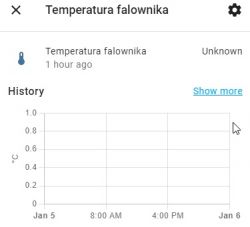
Sesjusz wrote:Akir, it looks beautiful.
Could you please send your configuration in a free moment?I have no idea what is wrong with me. Do you have the latest dongle firmware * 126? And inverter * 140?
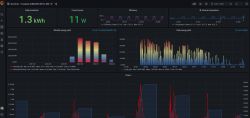
Sesjusz wrote:Akir, it looks beautiful.
Could you please send your configuration in a free moment?I have no idea what is wrong with me. Do you have the latest dongle firmware * 126? And inverter * 140?
sensor:
- platform: huawei_solar
host: '192.168.0.161'
optimizers: false
battery: false
slave: 1
- platform: template
scan_interval: 1
sensors:
daily_yield:
friendly_name: "dzienna_produkcja"
value_template: "{{ state_attr('sensor.sun2000_6ktl_m0', 'daily_yield') }}"
unit_of_measurement: "kWh"
Sesjusz wrote:I am a beginner in HA and here I feel that it is even higherI have HA installed on Debian, I think I would have to compile and run your program as a deamon, I understand that it integrates with the HomeAssistant API and throws data into it.
Sesjusz wrote:I wanted to make a rule at home that when I have a production greater than X, it starts my socket with a certain power-hungry device plus a few more actions, so I wanted an HA, in which I would also operate a number of sensors. At this point, it seems easiest to get the script to work. But I will post your solution, maybe I can get it started, google, read ...
akir19 wrote:I am not a fan of charts, I saw on some home assistant forum our compatriot wrote down the charts beautifully.
Sesjusz wrote:ak12345 - after updating the firmware, I had to do a quick configuration again and the most important step was to find the optimizers again, without that, my production did not start. So a downgrade wouldn't help either. Perhaps it is better to stay on the new firmware, but do this initial configuration by logging directly to the inverter's wifi and there on the installer's account.
By the way, apparently on the new firmware for the dongle (and having the new firmware 140 of the inverter enabled full TCP modbus communication), you can connect the inverter to your home network via the Ethernet cable and download the data to the HomeAssistant via the inverter's IP. There is no need to put a wifi computer a few meters from the inverterI have a question for you - how did you implement such a connection with HA? Do you use wifi and download data from the inverter or using the "KIOSK" link? Or maybe you are already downloading the cable on the new dongle firmware?
gitpusher wrote:If you are not on the topic, I actually advise you not to, because you guessed right that you have to pull rust and compile a project on your own - it is a bit of fun with it and you have to sit a bit on Linux topics ...
It has nothing to do with home assistant or its API. On the one hand, I talk to the inverter - on the other hand, I sign up for influxdb. From this you can make graphs in graphs and that's all I need at the moment.
Sesjusz wrote:I wanted to make a rule at home that if I have a production greater than X, it starts my socket with a certain power-hungry device plus a few more actions
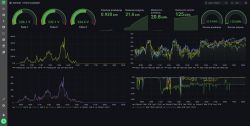
akir19 wrote:How to make a template to count the production from the last month?
utility_meter:
miesieczna_produkcja:
source: sensor.total_yield
cycle: monthly
roczna_produkcja:
source: sensor.total_yield
cycle: yearlyutility_meter:
roczna_produkcja_5maj:
source: sensor.total_yield
cron: "0 0 5 5 *"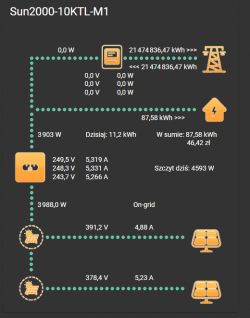
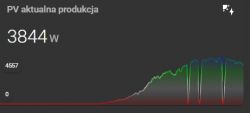
qrko wrote:
How is it done? I don't see anything like that there. I uploaded the dongle through the SUN2000 app.
oliniusz wrote:You can also turn the inverter off and on. When he gets up, Dongle issues AP for a few minutes.the dongle was not locally visible when I connected through the app directly to the inverter. Apparently, you can disconnect and connect the dongle, then it works in AP mode for some time.
oliniusz wrote:After logging in: Plants -> Device -> Upgrade Management
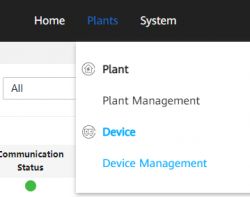
qrko wrote:You can also turn the inverter off and on. When he gets up, Dongle issues AP for a few minutes.
qrko wrote:Everything is clear, I have no authorization, so I could not find it.
oliniusz wrote:I'm pretty sure then it needs to be physically turned off and on,
oliniusz wrote:Man, it's linden. Not sure if you have a user or farm owner account?
jamzed wrote:Does ModBus work for you in the inverter AP (ktl-m1) in the SPC140 version (the one on 192.168.200.x: 502)? Because I noticed that it is no longer available and I do not have permission to download the Release Notes ...
oliniusz wrote:jamzed wrote:Does ModBus work for you in the inverter AP (ktl-m1) in the SPC140 version (the one on 192.168.200.x: 502)? Because I noticed that it is no longer available and I do not have permission to download the Release Notes ...
You need to connect directly to the inverter via the app and enable the appropriate option, unless it was somewhere in the communication settings. I can go check and take a screenshot later, but it's fairly easy to find.
